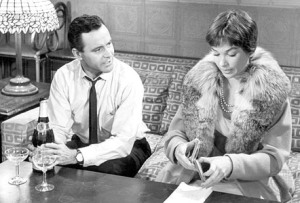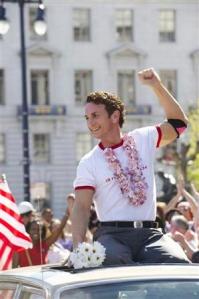Love classic rom coms and screwballs? Hate what the genre has become? You’re not the only one. Maureen Dowd interviewed Sam Wasson, who wrote Fifth Avenue, 5 a.m., a behind-the-scenes book about the making of Breakfast at Tiffany’s, in the op-ed section of the New York Times. The interview focuses on the demise of romantic comedies and the difference between classic rom coms and those of today. I thought Wasson made valid points, and I share his sadness at the lack of truly witty and romantic films these days. I especially liked his remark about one of my all-time favorite movies:
“If people only realized that Paramount in the ’30s and ’40s was the golden age of American wit. Algonquin Round Table, eat your black hearts out. The question is, will there be a backlash? A renaissance? I don’t think people realize how dire the situation is. I mean culturally, emotionally, the whole idea of romance is gone, gone, gone. … And I don’t care how good the novelist, I’ve never read anything that touches Kate Hepburn and Cary Grant in ‘Bringing Up Baby.’ Is it too early to drink?”
His comment inspired me to compile a list of my favorite romantic comedies. Forget about your latest Katherine Heigl flick. These are timeless gems of humor and romance that treat love with wit and intelligence. Check some of them out. They’re in no particular order.
1. Bringing Up Baby (1938): This film is, in my opinion, the ultimate screwball comedy. Susan (Katharine Hepburn) is a madcap (I love that word, don’t you? It’s thrown around a lot in this genre, but it’s never been more true than in this movie) heiress. David (Cary Grant) is a bespectacled paleontologist waiting for the last bone to complete his dinosaur skeleton. He also happens to be in consideration for a million-dollar grant. But when he runs into Susan, she starts making his life difficult with various shenanigans involving a leopard named Baby and a yappy dog named George (the famous Skippy of The Thin Man). Slapstick, fast-paced banter, and general hilarity ensue, all while the characters (at times begrudgingly) fall in love. See it! And if you get the special edition DVD, listen to Peter Bogdanovich’s commentary; it’s great.

2. Annie Hall (1977): If you’re familiar with Woody Allen, you know he’s witty. And you know he pretty much specializes in funny romances about neurotic people. This film won the Academy Award for Best Picture of 1977. A lot of people thought it should have been Star Wars. I think it was one of the coolest, most refreshing decisions the Academy’s ever made. The film is about a comedian named Alvy (Allen) and his relationship with a carefree aspiring singer named Annie Hall (Diane Keaton, in very cool clothes). The film tells the story of their relationship in an offbeat, original format. The plot is nonlinear, beginning in the middle of their relationship and then revealing how they met, then jumping back and forth between time periods. But it’s incredibly smooth and easy to follow. Allen uses fresh techniques like subtitles for people’s thoughts and split screen. The fourth wall does not exist, and there’s even an animated scene. It’s a quirky, honest portrayal of romance, and I think it’s Woody Allen’s best.

3. The Philadelphia Story (1940): There’s nothing like a good Katharine Hepburn comedy. She was so wonderfully witty. And when Cary Grant and Jimmy Stewart are invited into the mix, it’s even better. The film is about Tracy Lord (Hepburn), who has divorced C.K. Dexter Haven (Grant) and is remarrying. But during preparations for her wedding, a journalist (Stewart) arrives to cover the event, and her ex-hubby shows up, too. She’s torn between her ex, the cute new reporter, and her fiance. It’s a light, smart film, made excellent by the incomparable Hepburn.

4. The Awful Truth (1937): Cary Grant and Irene Dunne star in this great screwball comedy about a couple getting divorced. Not to be confused with The Ugly Truth (Please don’t confuse them!), the film is a tongue-in-cheek exploration of marriage and divorce, and the leads are simply wonderful. Skippy’s in this one, too. He’s kind of the mascot of the 1930s screwball comedy.

5. Barefoot in the Park (1967): This film is based on a Neil Simon play, so you know it’s good. It’s about a newly married couple (Jane Fonda and Robert Redford) moving into their first apartment. It’s not an easy transition. They deal with various complications, such as a leaking roof, a tiny bedroom, weird neighbors, and the like. The leads are hilarious and lovable, and the story, while laugh-out-loud hilarious, stresses the importance of sticking together as a couple.

6. My Favorite Wife (1940): This comedy, also starring Grant and Dunne, is about a woman who was believed to be dead, but comes back after being deserted on an island for years only to find out that her husband has remarried. The couple must deal with this problem while figuring out if they still love each other. It’s wacky and romantic.
7. Breakfast at Tiffany’s (1961): Who could forget this one? It’s based on a novella by Truman Capote, but it’s not exactly the same story. In the film, Holly Golightly (the always-charming Audrey Hepburn) is a socialite and “call girl” who falls in love with her writer neighbor (George Peppard). The film isn’t flawless. In fact, it’s quite campy and melodramatic at times, but it’s a classic. No one compares to Audrey Hepburn. She’s an icon. And who doesn’t love “Moon River”?

8. The Apartment (1960): This film was directed by Billy Wilder, so you know it’s a good one. It has the most drama out of any of the comedies on this list, but it’s still an ideal rom com. It’s about a businessman (Jack Lemmon, of course) who tries to impress his higher-ups by letting them conduct secret rendezvous in his apartment. He ends up falling for his boss’s mistress (the heart-breaking Shirley MacLaine), unaware of her complicated situation. Lemmon is charming, and it’s an adorable little film. It won Best Picture, too.

9. It Happened One Night (1934): Another great screwball comedy that won all the major categories at the Academy Awards (Picture, Actor, Actress, Directing, Screenplay). It’s the story of a spoiled heiress (Claudette Colbert) who runs away from home and ends up hitch-hiking with a reporter (Clark Gable) who’s interested in a scoop. Sound familiar? Yeah, the plot was reworked multiple times, including in Roman Holiday. But this one is special. It’s sweet and witty.
10. Amelie (2001): This one’s an unusual romantic comedy that I’ve already written about. It’s simply a make-you-smile, feel good movie about love and human relationships.
 Shakespearean film adaptations are always interesting to witness. They run the gamut from faithful (Olivier) to creative (Luhrmann). Julie Taymor’s Titus, based on Titus Andronicus, falls under the creative category. She brings her unique visual style to the project, and it works beautifully.
Shakespearean film adaptations are always interesting to witness. They run the gamut from faithful (Olivier) to creative (Luhrmann). Julie Taymor’s Titus, based on Titus Andronicus, falls under the creative category. She brings her unique visual style to the project, and it works beautifully.








 I noticed something at the movie theater today. Well, besides the fact that the theater spelled the title of the movie incorrectly on the marquee, while using a word that doesn’t even exist. After I got over that disappointment, I noticed that most of the audience for The Kids Are All Right (2010) certainly weren’t kids. Not even close. And that’s only partially all right with me.
I noticed something at the movie theater today. Well, besides the fact that the theater spelled the title of the movie incorrectly on the marquee, while using a word that doesn’t even exist. After I got over that disappointment, I noticed that most of the audience for The Kids Are All Right (2010) certainly weren’t kids. Not even close. And that’s only partially all right with me.





